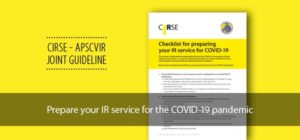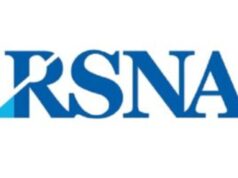 The Cardiovascular and Interventional Radiological Society of Europe (CIRSE) and the Asia Pacific Society of Cardiovascular and Interventional Radiology (APSCVIR) have jointly published a checklist for interventional radiologists to use when preparing their department for COVID-19 patients.
The Cardiovascular and Interventional Radiological Society of Europe (CIRSE) and the Asia Pacific Society of Cardiovascular and Interventional Radiology (APSCVIR) have jointly published a checklist for interventional radiologists to use when preparing their department for COVID-19 patients.
The full checklist, as well as other COVID-19 resources collated by CIRSE, is available here.
First author Bien Soo Tan (Singapore General Hospital, Singapore) and colleagues from South Korea, France, Switzerland, the UK, Germany, and New Zealand write: “The primary consideration in preparing the IR [interventional radiology] service for COVID-19 is prevention of intra hospital transmission so as to protect patients and health care workers from being contaminated or infected, while providing safe IR care for patients.”
Addressing the international IR community, CIRSE president Afshin Gangi stressed the importance of a rapid and coordinated IR response to the current coronavirus outbreak. He said: “The spreading COVID-19 pandemic has forced all of us to adjust to a new reality. While IR departments are trying to delay most non-emergency procedures until after the crisis, some interventions cannot be postponed. It is therefore adamant for interventional radiologists to adapt their departments accordingly, from the set-up of a COVID-19 task force to implementing infection prevention protocols and dedicated workflows.
“I am convinced that weathering this storm can only be done together, and when it has finally subsided, we will be stronger for it, as physicians, individuals and as a community.”
Outline of checklist
- Set up COVID-19 task force or crisis management team in radiology/IR to sort out all COVID-19 related issues.
- Implement and refresh infection prevention and control practices.
- Create COVID-19 suspect case definitions and expanded case definitions.
- Ensure appropriate personal protective equipment (PPE) is used. PPE recommendation for performing IR procedures on known COVID-19 patients and patients suspected of COVID-19 is: surgical cap, N95/FFP2 mask, eye protection (face shield or goggles), full length long-sleeved gown and gloves. For all other categories of patients, the PPE recommendation is stratified according to COVID-19 infection risk.
- Use of powered air-purifying respirator is recommended when performing aerosol-generating procedures on suspected or confirmed COVID-19 patients.
- Introduce screening measures to the hospital—this includes temperature screening and the completion of health declaration forms upon entry to the institution.
- Limit the number of visitors; there should be a strict visitor policy.
- Have designated wards for COVID-19 management.
- Segregate inpatients from outpatients. Procedures should be performed in the outpatient setting where possible.
- Reduce workload and cancel or defer elective procedures.
- All requests for IR procedures for suspected or confirmed COVID-19 patients must be carefully vetted and prioritised.
- Dedicated workflows need to be written and rehearsed to prevent cross transmission.
- Segregation of staff into smaller functional teams is a key strategy to prevent the entire service from being decimated due to healthcare worker infection or quarantine.
- Implement social distancing measures—meetings, such as multidisciplinary tumour board discussion, should be held over video calls, staff should eat separately; patients should have consultations over the phone.
- Staff leave and travel advisory.
- Staff surveillance should be implemented. This includes twice daily measuring of temperature.
- Contact tracing: the names and designation of all staff involved in every IR procedure should be recorded. Staff rosters should be updated daily and archived.
- Rapid dissemination of accurate information is critical.
- Staff morale, welfare, and psychological support systems should be put in place.
- Keep track of logistics: PPE usage and available stocks need to be tracked. It is important to stress at the institutional level that IR is given priority for PPE.
- A plan must be devised for the management of residents and fellows. If feasible, residency and fellowship teaching should continue using video conferencing platforms.
- Research activities are likely to be curtailed and IR should align with the prevailing institutional policies and directives.
Share your story
If you have been affected or have any information, we’d like to hear from you. You can get in touch by emailing the editor at [email protected] and one of our journalists may contact you to discuss further.













